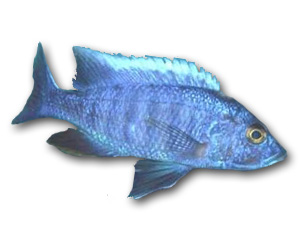Blue Ahli

Quick Stats
| Size | 7" (18cm) |
|---|---|
| Tank | 180 litres + |
| Swimming Area | Bottom, middle |
| Ph | 7.6 to 8.5 |
| Temperature | 74ºF to 80ºF(23-27°C) |
| Food | Flaked, pelleted, live and frozen foods |
Common Name:
Blue Ahli, Blue Hap, Electric Blue Ahli.
Distribution:
Africa, lake Malawi. One of the Great rift lakes.
Colouration:
The males turn the electric blue color. Females and juveniles are completely gray.
Lifespan:
10 years +
Maintenance:
10 to 20% weekly water changes. Keeping the Malawi Cichlids is not difficult as long as certain requirements are met. They should be kept in a large community aquarium with other Mbuna type fish like the species from the Labeotropheus, Melanochromis as well as others from the Pseudotropheus Genus. A grouping including more than 10 haplochromis and peacock cichlids is recommended. Male Blue Ahli should not be combined, unless they have adequate hiding areas from each other. A single male with two or three females works quite well.
Feeding:
Blue Ahli will eat flake foods, algae based flake foods and cichlid pellets. Do not feed them live worms, beefheart or live brine shrimp, as these can bloat and kill the fish.
Substrate:
Sand. There should be little or no gravel in the tank.
Tank Decor:
Blue Ahli are very territorial, aggressive fish. They need large swimming spaces, so a 90 gallon tank is recommended. Rocks and other hiding areas can be provided, however they traditionally stay away from the rocks due to fear of mbunas, like the Cobalt Blue Zebra, the Red Zebra or the Blue Johanni. Neverthess, Blue Ahlis can hold their own against mbunas. They enjoy plants, but will destroy them.
Filtration:
Provide good filtration and do frequent water changes.
Biotype:
Rocky regions of the lake free of sediment.
Breeding:
Eggs are fertilized externally before the female picks them up to brood in her mouth for a period of approximately two weeks. This protection makes it easy to breed them in a community tank. Move the female to a separate tank just before she releases the brood. Males are easy to sex past juvenile stage because males are bright blue and females remain grey.